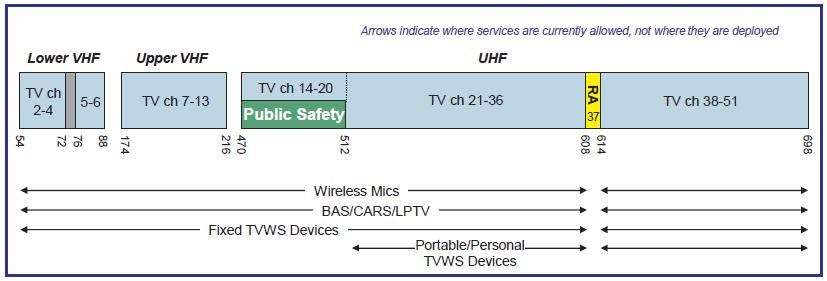On November 30, the FCC adopted a Notice of Proposed Rulemaking (NPRM) as a preliminary step toward making the current TV broadcast spectrum available for use by fixed and mobile wireless broadband services. The proposed rules would do three things: 1) make fixed and mobile wireless services co-primary with broadcasting in the FCC’s Table of Frequency Allocations, 2) create a regulatory structure giving two or more TV stations the option to share one 6 MHz channel, and 3) improve VHF TV reception through power increases and adoption of receiver antenna standards. No service rules are being proposed; they’re to come later. Congress has yet to approve incentive auction authority.
Making wireless services co-primary with broadcasting is a simple change to the Table. Doing it now facilitates things when service rules are written later.
Channel sharing is straightforward, at least technically. Two or more stations would share a single 19.4 Mbps data stream in a 6 MHz channel and would multiplex their programming. It’s possible to send two HD programs in one stream, sort of. Due to limitations in video compression, depending on the programming content, one or both programs would suffer more picture quality degradation than if only one program were sent; stations will have to decide who takes the quality hit and when. Instead of sending two HD programs, three or more stations might decide to send standard-definition programs. Another issue with channel sharing is that when a station moves to a common transmitter site, it may lose some of its existing coverage. How should these service losses be balanced against benefits? Non-technical issues include media ownership rules and must-carry rights.
The FCC also wants to improve VHF TV reception. Today, reception at VHF suffers from high noise and inefficient receiver antennas, compared to UHF. Improving VHF TV would not only help today’s VHF stations, it would make that band more attractive for a possible repacking of some UHF stations into VHF, freeing more UHF spectrum for mobile broadband.
Not much can be done to reduce noise; to help address the issue, the FCC plans to allow some stations to increase power to the extent that they don’t cause new interference to other stations. For receiving antennas, the FCC proposes that antennas be required to comply with standards ANSI/CEA-2032-A for indoor TV performance, which incorporates standard ANSI/CEA-744-B for antenna measurement. Conformance with these standards would result in higher-gain indoor antennas and thus better quality reception. Not mentioned by the FCC is CEA’s standard for smart antennas, CEA-909, which uses signal quality data from the TV to make antenna adjustments that reduce noise, increase signal strength, and improve impedance matching. There hasn’t been much pickup of that standard that I can tell. Attention by the FCC might reinvigorate that technology; it already exists in other wireless services and doesn’t have to be reinvented for broadcasting.
As it does on many documents relating to the National Broadband Plan and spectrum, the FCC in the NPRM reiterates that the Plan recommends making 500 MHz spectrum available for wireless broadband in 10 years, with 300 MHz of that for mobile flexible use within 5 years. Since the FCC refreshed this estimate with release of a related Omnibus Broadband Initiative technical paper on October 21, I thought the FCC might address that paper and its analysis in this NPRM. It does not. The assumptions used by that analysis are out of date or incomplete. To the extent that the FCC continues to rely on the 300 MHz estimate, it should, sooner rather than later, make it a prime topic for consideration.
For views on the NPRM from a legal perspective, see the CommLawBlog and the Broadcast Law Blog.
